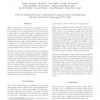Free Online Productivity Tools
i2Speak
i2Symbol
i2OCR
iTex2Img
iWeb2Print
iWeb2Shot
i2Type
iPdf2Split
iPdf2Merge
i2Bopomofo
i2Arabic
i2Style
i2Image
i2PDF
iLatex2Rtf
Sci2ools
ICRA
2002
IEEE
2002
IEEE
Mobility Enhancements to the Scout Robot Platform
When a distributed robotic system is assigned to perform reconnaissance or surveillance, restrictions inherent to the design of an individual robot limit the system’s performance in certain environments. Finding an ideal portable robotic platform capable of deploying and returning information in spatially restrictive areas is not a simple task. The Scout robot, developed at the University of Minnesota, is a viable robotic platform for these types of missions. The small form factor of the Scout allows for deployment, placement, and concealment of a team of robots equipped with a variety of sensory packages. However, the design of the Scout requires a compromise in power, sensor types, locomotion, and size; together these factors prevent an individual Scout from operating ideally in some environments. Several novel attempts to address these deficiencies have been implemented and will be discussed. Among the prototype solutions are actuating wheels, allowing the Scout to increase grou...
| Added | 15 Jul 2010 |
| Updated | 15 Jul 2010 |
| Type | Conference |
| Year | 2002 |
| Where | ICRA |
| Authors | Andrew Drenner, Ian T. Burt, Tom Dahlin, Bradley Kratochvil, Colin McMillen, Bradley J. Nelson, Nikolaos Papanikolopoulos, Paul E. Rybski, Kristen Stubbs, David Waletzko, Kemal Berk Yesin |
Comments (0)

